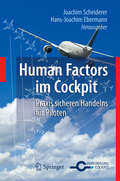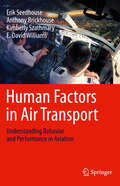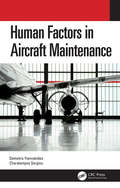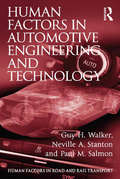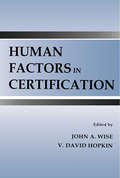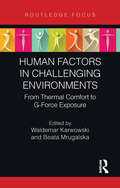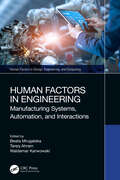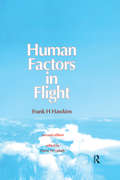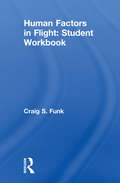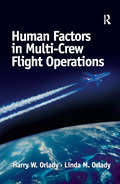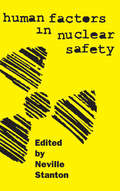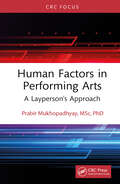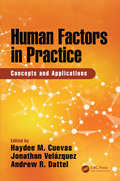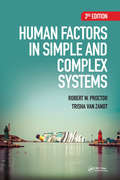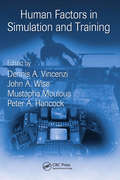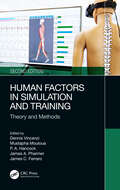- Table View
- List View
Human Factors im Cockpit
by Joachim Scheiderer Hans-Joachim EbermannDie Hauptaufgabe eines Verkehrspiloten besteht darin, sein Flugzeug sicher von A nach B zu bringen. Dabei ist das Wissen um eine optimale Unfallprävention noch immer verbesserungsfähig. In dem Buch wird dargelegt, wann und unter welchen Umständen Unfälle passieren und wie sie sich vermeiden lassen. Demnach dient insbesondere das Crew Ressource Management (CRM) der Unfallprävention. Die Autoren, fast ausnahmslos Verkehrspiloten, definieren die Prinzipien des CRM und zeigen anschließend auf, wie dessen Inhalte in die Praxis übertragen werden können.
Human Factors in Air Transport: Understanding Behavior and Performance in Aviation
by Erik Seedhouse Anthony Brickhouse Kimberly Szathmary E. David WilliamsThis textbook provides students and the broader aviation community with a complete, accessible guide to the subject of human factors in aviation. It covers the history of the field before breaking down the physical and psychological factors, organizational levels, technology, training, and other pivotal components of a pilot and crew's routine work in the field.The information is organized into easy-to-digest chapters with summaries and exercises based on key concepts covered, and it is supported by more than 100 full-color illustrations and photographs. All knowledge of human factors required in aviation university studies is conveyed in a concise and casual manner, through the use of helpful margin notes and anecdotes that appear throughout the text.
Human Factors in Aircraft Maintenance
by Demetris Yiannakides Charalampos SergiouThis book provides an in-depth analysis of human failure and its various forms and root causes. The analysis is developed through real aviation accidents and incidents and the deriving lessons learned. Features: Employs accumulated experience, and the scientific and research point of view, and recorded aviation accidents and incidents from the daily working environment Provides lessons learned and integrates the existing regulations into the human factors discipline Highlights the responsibility concerns and raises the accountability issues deriving from the engineers’ profession by concisely distinguishing human failure types Suggests a new approach in human factors training in order to meet current and future challenges imposed on aviation maintenance Offers a holistic approach in human factors aircraft maintenance Human Factors in Aircraft Maintenance is comprehensive, easy to read, and can be used as both a training and a reference guide for operators, regulators, auditors, researchers, academics, and aviation enthusiasts. It presents the opportunity for aircraft engineers, aviation safety officers, and psychologists to rethink their current training programs and examine the pros and cons of employing this new approach.
Human Factors in Alarm Design
by Neville StantonFocusing on the application of human factors and ergonomics in the design of alarm systems, this book brings together all the disparate areas in a single volume.; The aim of the book is to present current human factor issues regarding alarm design in a variety of setting, such as industrial alarm systems in process industries, aviation, autom
Human Factors in Auditory Warnings (Routledge Revivals)
by Neville A. Stanton Judy EdworthyFirst published in 1999, this book provides answers to many of the problems associated with the design and application of auditory warnings. It represents the position of contemporary auditory warnings research and development in a single unique volume. Application domains include air traffic control, aviation, emergency services, manufacturing, medicine, military and nuclear power. The contributors constitute many key experts in this area, some of whom are psychoacousticians, some psychologists and some ergonomists. Correspondingly, the chapters range from those covering basic topics such as audibility and localization of warnings, through psychological issues concerned with the relationship between design, understanding and the behavioural response, to the more general ergonomic issues of implementing the warnings in a particular context. Although each of the chapters takes a slightly different perspective, they all balance theoretical underpinning with practical application. The editors have undertaken to draw all of the contributions together by providing an overview of warnings research at the beginning of the book and summary of the contributions at the end. This book will appeal to all involved in the research, development, design and implementation of auditory warnings.
Human Factors in Augmented Reality Environments
by Weidong Huang Leila Alem Mark A LivingstonAdvances in hardware and networking have made possible a wide use of augmented reality (AR) technologies. However, simply putting those hardware and technologies together does not make a "good" system for end users to use. New design principles and evaluation methods specific to this emerging area are urgently needed to keep up with the advance in technologies. Human Factors in Augmented Reality Environments is the first book on human factors in AR, addressing issues related to design, development, evaluation and application of AR systems. Topics include surveys, case studies, evaluation methods and metrics, HCI theories and design principles, human factors and lessons learned and experience obtained from developing, deploying or evaluating AR systems. The contributors for this cutting-edge volume are well-established researchers from diverse disciplines including psychologists, artists, engineers and scientists. Human Factors in Augmented Reality Environments is designed for a professional audience composed of practitioners and researchers working in the field of AR and human-computer interaction. Advanced-level students in computer science and engineering will also find this book useful as a secondary text or reference.
Human Factors in Automotive Engineering and Technology (Human Factors in Road and Rail Transport)
by Neville A. Stanton Guy H. WalkerOffering a unique perspective on vehicle design and on new developments in vehicle technology, this book seeks to bridge the gap between engineers, who design and build cars, and human factors, as a body of knowledge with considerable value in this domain. The work that forms the basis of the book represents more than 40 years of experience by the authors. Human Factors in Automotive Engineering and Technology imparts the authors' scientific background in human factors by way of actionable design guidance, combined with a set of case studies highly relevant to current technological challenges in vehicle design. The book presents a novel and accessible insight into a body of knowledge that will enable students, professionals and engineers to add significant value to their work.
Human Factors in Certification (Human Factors in Transportation)
by John A. Wise V. David HopkinMuch has happened to certification and to human factors during the past few years. In this volume, the editors and other specialists discuss the topic of human factors applied to certification. They focus on core topics in the certification process that have emerged in the study of product certification in high-tech industries. The editors' purpose
Human Factors in Challenging Environments: From Thermal Comfort to G-Force Exposure (Body of Knowledge in Human Factors and Ergonomics)
by Waldemar Karwowski Beata MrugalskaIn human factors and ergonomics, professionals play a key role in shaping the compatibility between tasks, products, and environments with the needs of individuals. The most successful projects demonstrate a tight integration with the human experience, underscoring the importance of ergonomic design in promoting societal well-being. A human-centered approach to design and evaluation should be championed. This book addresses this issue with an approach that focuses on environmental conditions and ergonomics in physical settings.This book examines human factors and ergonomics across various industrial settings. From tackling challenges posed by thermal to extreme environments, the book offers an understanding of environmental ergonomics, resulting in better, more comfortable, and safer workspaces. It investigates critical topics such as G environments and +Gz Acceleration, equipping the reader with the knowledge to navigate and optimize various workplace conditions. Additionally, the reader will develop a good understanding of environmental ergonomics and understand how an appreciation of it can lead to practical and noticeable changes in their workplace.Human Factors in Challenging Environments: From Thermal Comfort to G-Force Exposure will be of interest to human factors and ergonomics professionals seeking to deepen their expertise and broaden their understanding of the field. It will also appeal to engineers, designers, and policymakers who are invested in creating safer and more efficient work systems.
Human Factors in Control Room Design: A Practical Guide for Project Managers and Senior Engineers
by Tex CrampinA succinct guide to a Human Factors programme of work This book provides a reference for project managers to assist in identifying the key rudiments of good Human Factors design. It is intended to be used in conjunction with an appointed Human Factors manager as part of a detailed design programme, read by all engineers and designers in order to establish a wide understanding across the whole team of the importance of Human Factors. Human Factors in Military and Industrial Control Room Design offers succinct advice, tailored for rapid injection into complex Human Factors programmes, together with applicability to any control room design, military or industrial. Applications include warship control rooms, command centres, fire and accident response centres, chemical plants, nuclear installations, oil rigs, refineries and other similar industries. Key features: A template for a thorough Human Factors programme of work. Applicability to any control room design. Aims to address operator workload and optimise system performance, comfort and safety. Can save significant costs by optimised system integration and enhanced system operation. It is advised that project managers use Human Factors in Military and Industrial Control Room Design as a template to develop a control room "Operating Philosophy" and "Human Computer Interface (HCI) Style Guide" for their own purposes within the constraints of their specific industry.
Human Factors in Engineering: Manufacturing Systems, Automation, and Interactions (Human Factors in Design, Engineering, and Computing)
by Waldemar Karwowski Tareq Ahram Beata MrugalskaThis book addresses aspects of human factors in engineering and provides a detailed discussion of novel approaches, systems engineering tools, artificial cognitive systems, and intelligent technologies and automation. It presents applications in diverse areas, including digital manufacturing, transportation, infrastructure development, and cybersecurity. This book: • Merges the engineering perspective with the human factors and social dimension of computing and artificial intelligence–based technologies. • Covers technological development of human factors engineering and the human dimension in applications across all areas of modern society. • Relates to human behavior in the context of technology and systems interactions. • Discusses the design and the appropriation of 3D printing techniques in the management of an innovative product system. • Presents systems engineering tools, user experience methodologies, artificial cognitive systems, intelligent technologies, and automation. The text is for students, professionals, and researchers in the fields of ergonomics, human factors, industrial engineering, and manufacturing engineering.
Human Factors in Flight
by Frank H. HawkinsThe late Captain Frank H Hawkins FRAes, M Phil, was Human Factors Consultant to KLM, for whom he had flown for over 30 years as line captain and R & D pilot, designing the flight decks for all KLM aircraft from the Viscount to the Boeing 747. In this period he developed and applied his specialization in Human Factors. His perception of lack of knowledge of Human Factors and its disastrous consequences led him to initiate both an annual course on Human Factors in Transport Aircraft Operation at Loughborough and Aston Universities, and the KLM Human Factors Awareness Course (KHUFAC). A consultant member of SAE S-7 committee, he was also a member of the Human Factors Society and a Liveryman of the Guild of Air Pilots. He was keynote speaker at the ICAO Human Factors Seminar held in St Petersburg, Russia in April 1990. About the Editor The late Captain Harry W Orlady was an Aviation Human Factors Consultant and a former Senior Research Scientist for the Aviation Safety Reporting System (ASRS); he also worked with NASA/Ames, with private research firms and the FAA in its certification of the Boeing 747-400 and the McDonnell-Douglas MK-11. As a pilot with United Airlines he flew 10 types of aircraft ranging from the DC-3 to the Boeing 747. He conducted studies in ground and flight training, Human Factors, aviation safety and aeromedical fields, and received several major awards and presented nearly 100 papers or lectures. He was an elected fellow of the Aerospace Medical Association; a member of the Human Factors Society, of ICE Flight Safety and Human Factors Study Group, and the SAE Human Behavioural Technology and G-10 Committees.
Human Factors in Flight: Student Workbook
by Craig S. FunkThis student workbook is designed to help identify and master the key concepts in the Human Factors in Flight textbook. It provides the essential student materials which supplement the student text learning package. Each section provides performance objectives, followed by questions to prepare students for class discussion and examinations.
Human Factors in Land Use Planning and Urban Design: Methods, Practical Guidance, and Applications (Human Factors and Socio-technical Systems)
by Neville A. Stanton Guy H. Walker Paul M. Salmon Nicholas J. StevensThe integration of Human Factors in Land Use Planning and Urban Design (LUP & UD) is an exciting and emerging interdisciplinary field. This book offers practical guidance on a range of Human Factors methods that can be used to rigorously and reliably explore LUP & UD. It provides new ways to interpret urban space and detail context sensitive analysis for the interpretation and design of our surroundings. The methodologies outlined allow for the consideration of the technical aspects of the built environment with the necessary experience and human centered approaches to our urban and regional settings. This book describes 30 Human Factors methods for use in the LUP & UD context. While it explores theory, it also focuses on the question of what Human Factors methods are; their advantages and disadvantages; step-by-step guidance on how to carry them out; and case studies to guide the reader. Describes the practice and processes associated with urban and regional strategic planning Constructed so that students, practitioners, and researchers with an interest in one particular area of Human Factors can read the chapters independently from one another
Human Factors in Lighting
by Peter Robert BoyceThe availability of electric lighting has changed the lives of people the world over, yet as a major user of electricity it has come under increasing scrutiny in recent years. This scrutiny has focused largely on the environmental consequences, with little consideration of the benefits of lighting. Human Factors in Lighting, Third Edition restores
Human Factors in Multi-Crew Flight Operations
by HarryW. OrladyWith the pace of ongoing technological and teamwork evolution across air transport, there has never been a greater need to master the application and effective implementation of leading edge human factors knowledge. Human Factors in Multi-Crew Flight Operations does just that. Written from the perspective of the well-informed pilot it provides a vivid, practical context for the appreciation of Human Factors, pitched at a level for those studying or engaged in current air transport operations. Features Include: - A unique seamless text, intensively reviewed by subject specialists. - Contemporary regulatory requirements from ICAO and references to FAA and JAA. - Comprehensive detail on the evolutionary development of air transport Human Factors. - Key statistics and analysis on the size and scope of the industry. - In-depth demonstration of the essential contribution of human factors in solving current aviation problems, air transport safety and certification. - Future developments in human factors as a 'core technology'. - Extensive appendices, glossary and indexes for ease of reference. The only book available to map the evolution, growth and future expansion of human factors in aviation, it will be the text for pilots and flight attendants and an essential resource for engineers, scientists, managers, air traffic controllers, regulators, educators, researchers and serious students.
Human Factors in Nuclear Safety
by Neville StantonThere is a growing recognition amongst those involved with the creation and distribution of nuclear power of the value and positive impact of ergonomics, recognition heightened by the realization that safety incidents are rarely the result of purely technical failure. This work provides insights into plant design, performance shaping factors,
Human Factors in Performing Arts: A Layperson's Approach
by PRABIR MUKHOPADHYAYThis captivating book explores the intersection where performing art meets human interaction and delves into the application of human factors’ principles in this field. From music and theatre to cinema and magic shows, indoor and outdoor performances are analyzed from a human factors perspective. Written in an accessible language, this book offers a comprehensive overview of how human factors influence various facets of the performing arts, enriching the experience for both performers and audiences alike.This book uncovers how human factors principles can enhance performance across script writing, stage design, crowd engagement, and more. Through engaging storytelling and practical examples, readers will learn about the intricacies of audience attention, ambience creation, and the importance of feedback in shaping memorable performances. Whether you're a seasoned professional or an aspiring events manager looking to enhance the user experience, this book provides valuable insights into optimizing the human experience within the realm of performing arts making it safe and memorable for all.Ideal for professionals in human factors, occupational health and safety, as well as those working in the performing arts industry, Human Factors in Performing Arts: A Layperson's Approach serves as a valuable resource for theatre managers, event organizers, and anyone involved in orchestrating small or large-scale performances. With its blend of theory and real-world application, it offers a fresh perspective on human factors and the art of entertainment, making it essential reading for anyone passionate about elevating their craft.
Human Factors in Practice: Concepts and Applications
by Haydee M. Cuevas Jonathan Velázquez Andrew R. DattelHuman Factors in Practice: Concepts and Applications is written for the practitioner who wishes to learn about human factors (HF) but is more interested in application (applied research) than theory (basic research). Each chapter discusses the application of important human factors theories, principles and concepts, presented at a level that can be easily understood by layman readers with no prior knowledge or formal education in human factors. The book illustrates to the non-HF practitioner the many varied domains in which human factors has been applied as well as serving to showcase current research in these areas. All chapters address the common overarching theme of applying human factors theories, principles and concepts to address real-world problems, and follow a similar structure to ensure consistency across chapters. <P><P>Standard sections within each chapter include a discussion of the scientific underpinnings, a description of relevant HF methods and guidance on sources of further information, case studies to illustrate application, and a summary of likely future trends. Each chapter concludes with a short list of key terms and definitions to enhance the reader’s understanding of the content. Featuring specialist contributors from a variety of disciplines and cultural backgrounds, the book represents a diverse range of perspectives on human factors and will appeal to a broad international audience. It is consciously not a classroom textbook but rather intended to be read at the workplace by non-HF practitioners, and written specifically with their needs in mind. Reading this book will give all practitioners a solid grounding in modern human factors and its application in real-world situations.
Human Factors in Privacy Research
by Nina Gerber Alina Stöver Karola MarkyThis book covers topics needed to be considered in research around usable privacy. The book starts from a psychological perspective and introduces readers to basic behavioral theories and models that can explain end-user privacy behavior (including the “privacy paradox”) on a theoretical level. Subsequently, an introduction to different study methods (e.g., experiment, survey, interviews, co-creation) used in usable privacy research is given. Based on this, different methodological aspects, such as identifying appropriate questionnaires, and applying User-Centered Design, will be discussed. Finally, the book describes application areas for privacy research such as dark patterns and presents solutions for privacy protection, e.g., regarding consent-giving and PETs. The book aims to bring together the different research approaches to the topic of usable privacy, which often originate from computer science, psychology, and law, and provide a methodologically sound basis for researchers who want to delve deeper into this topic.This is an open access book.
Human Factors in Product Design: Current Practice and Future Trends
by W. S. Green P. W. JordanManufacturers are becoming more aware of human factors in product design as a major competitive issue. In many product areas, manufacturers have reached a technology ceiling, which simply means that it is increasingly difficult to get ahead of the competition in terms of, for example, functionality, technical reliability or manufacturing costs. As
Human Factors in Simple and Complex Systems, Third Edition
by Robert W. Proctor Trisha Van ZandtRecently, there have been a number of advances in technology, including in mobile devices, globalization of companies, display technologies and healthcare, all of which require significant input and evaluation from human factors specialists. Accordingly, this textbook has been completely updated, with some chapters folded into other chapters and new chapters added where needed. The text continues to fill the need for a textbook that bridges the gap between the conceptual and empirical foundations of the field.
Human Factors in Simulation and Training
by Peter A. Hancock Mustapha Mouloua Dennis A. Vincenzi John A. WiseMeasure twice, cut once. Although applicable to all areas of human factors research, the old adage is especially relevant to simulation and training. As a tool, simulation is an aid to the imagination, however, if incorrectly or inadequately used, it can lead to inaccurate outcomes that not only limit the possibilities but potentially cause harm. A
Human Factors in Simulation and Training: Application and Practice
by Dennis Vincenzi, Mustapha Mouloua, P. A. Hancock, James A. Pharmer, and James C. FerraroHuman Factors in Simulation and Training: Application and Practice covers the latest applications and practical implementations of advanced technologies in the field of simulation and training. The text focuses on descriptions and discussions of current applications and the use of the latest technological advances in simulation and training. It covers topics including space adaptation syndrome and perceptual training, simulation for battle-ready command and control, healthcare simulation and training, human factors aspects of cybersecurity training and testing, design and development of algorithms for gesture-based control of semi-autonomous vehicles, and advances in the after-action review process for defence training. The text is an ideal read for professionals and graduate students in the fields of ergonomics, human factors, computer engineering, aerospace engineering, occupational health, and safety.
Human Factors in Simulation and Training: Theory and Methods
by Dennis Vincenzi, Mustapha Mouloua, P. A. Hancock, James A. Pharmer, and James C. FerraroHuman Factors in Simulation and Training: Theory and Methods covers theoretical concepts on human factors principles as they apply to the fields of simulation and training in the real world. This book discusses traditional and nontraditional aspects of simulation and training. Topics covered include simulation fidelity, transfer of training, limits of simulation and training, virtual reality in the training environment, simulation-based situation awareness training, automated performance measures, performance assessment in simulation, adaptive simulation-based training, and scoring simulations with artificial intelligence This book will be a valuable resource for professionals and graduate students in the fields of ergonomics, human factors, computer engineering, aerospace engineering and occupational health and safety.
